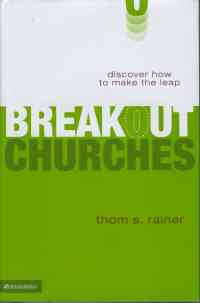

Thom S.
Rainer,
Thom Rainer and his research team seek to apply the methodology employed in Jim Collin’s book Good to Great. . . to churches. In particular he sought out churches he defined as “break out churches,” that is, churches that experienced a decline or plateau for many years and then had sudden growth—all under the same pastor. From a database of 52,333 churches Rainer reduced the number to evangelical churches that were able to supply needed data. The end result was that only thirteen fit that required criteria of a breakout church. These thirteen churches were each then grouped with three comparison churches that matched their demographics.
Rainer provides insightful conclusions through these comparisons:
1.
Almost all of the persons we
interviewed in the breakout churches know the basics of their doctrinal
beliefs. Very few of the laypeople in the
comparison churches knew anything about their churches’
doctrinal position.
2. Unlike the laypeople in the breakout churches, those in the comparison churches would often equivocate on matters related to doctrine of exclusivity. The laypeople in the breakout churches most often expressed certainty that explicit faith in Christ is the only way of salvation. Those in the comparison churches frequently questioned whether or not a “good” person of another religious faith might go to heaven as well. In other words, the comparison churches’ members often held theological positions in contradiction to the printed doctrinal positions of their churches.
3. Even when the interviewees of the comparison churches expressed positions congruent with the stated doctrinal position of their churches, we often found inconsistencies in their willingness to practice their beliefs. The clearest example of this reality was in the area of evangelism. They might believe that Christ is the only way of salvation, but they are unwilling or unable to share the gospel with non-Christians. In contrast, the majority of those we interviewed in the breakout churches were passionate about reaching people for Christ personally. They did not expect all evangelism to be done by the staff or a select few in the church. (p. 177)
I was struck by the importance of doctrine for the health and growth of a church. Often we attribute growth to a church’s friendliness, compassion of the congregation, or innovations in church services. Rainer’s comparisons, however, reveal the none of these is key to church growth.
Not only do breakout churches have different characteristics among their congregation, but it is also clear that their pastors are different as well. Rainer provides a model of leadership that is patterned on content in the book of Acts:
He concludes that fewer than 1% of senior pastors attain the level of legacy leadership (p. 45). He finds that one reason for the overall decline in attendance in American churches can be traced to the lack of legacy leaders in senior pastor positions.
The book challenges today’s churches to move on to excellence and not settle for mediocrity. This challenge is not easily met and often a crisis occurs before a break out church experiences substantial growth. A few churches are able to grow steadily, but most (8 out of 10) are in a steady decline. Rainer seeks to alert these declining churches to their present state.
Reviewed by Terry B. Ewell, September
2007.